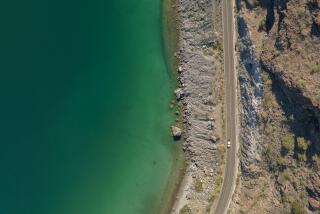For bikers, odd twists and turns
- Share via
Imagine a place where motorcycles outnumber everything else on the road 5 to 1 - a place where the bikes are small, the tank badges are in Mandarin and the seats are covered in tapestries. That place is China’s Xinjiang province, where I spent eight days tooling around on two wheels. Here, from a rider’s perspective, is what it was like and what you need to know.
TRAFFIC
In Xinjiang’s cities, traffic moves slowly -- about 30 mph max -- which is good because it’s utter pandemonium, some of it motorized. It is made up of people, donkey carts, taxis, bicycles, scooters, motorcycles and motorcycles that have been converted into trucks hauling slaughtered animals, bags of rice, tree stumps, construction debris and just about anything else you can think of. On the highways, traffic was sparse, consisting mostly of soot-spewing semis that have been packed to the point of tipping over. Passenger cars were rare and tended to be Porsches and Land Rovers.
ROAD QUALITY
The best riding road was the Karakorum Highway between Kashgar and Tashkurgan, where the pavement was so smooth it seemed to have been poured yesterday. The military checkpoints and tanks on this two-lane freeway give it away: The Karakorum is the main military thoroughfare between China and Pakistan. The rest of the roads we traveled in this part of the country were worn but otherwise in good shape. Some were warped from heat, others pockmarked and washed out in places.
ROAD RULES
Rules? There aren’t many. Vehicles can ride on the sidewalk or either side of the street, and they do. There are, however, speed limits. Top speeds are supposed to be 100 km, or 62 mph, but half my tour group was German and accustomed to the autobahn, so we were frequent violators. Even so, we were pulled over for speeding only once. It’s amazing what a country’s history of corporal punishment will do. No sirens were involved. The police officer just stepped into the road, waved a white-gloved hand and our Chinese tour guide hit the brakes. After confiscating our Chinese driver’s licenses and calling us each by a Chinese name we didn’t know we had, the officer threatened to take our licenses away but let us go instead.
ROAD HAZARDS
The main hazards were packs of animals and stacks of rocks. In rural areas, you never knew when you would round a corner and need to slow for yaks or goats. You also never knew when your front end might slam into a stone. They don’t use orange traffic cones in this part of the world. When a vehicle breaks down, the driver alerts oncoming traffic with a pile of rocks stacked in the middle of the road.
GASOLINE
Customers don’t pump the gas. At some stations, the gas isn’t even pumped straight into the tank. It’s pumped into a teapot, then poured in. Use of cellphones and video cameras is banned at gas stations because they fear the electronics will ignite the gasoline. Like almost everything else in China, gas is relatively inexpensive, costing less than in the U.S. And there’s never a line at the pump because so few people drive in the remote and impoverished outskirts of Xinjiang province. The gas stations were mostly plentiful, enormous, empty and overstaffed with attendants in matching McDonald’s-like outfits.
MOTORCYCLES
The tour company arranges for the motorcycles, offers options for insurance and takes care of acquiring the Chinese driver’s license (but you must have an international license, available through the auto club). Most of the bikes are from an endless array of Chinese manufacturers, though there were also many Japanese models. All were small, usually about 125 cc. Many of the scooters were electric. Regardless of make or model, the saddles were tapestry -- woven kilims. Bikes tended to be ridden by at least two people and sometimes entire families.
PROTECTIVE GEAR
Most riders don’t wear protective gear. On the rare occasion a rider is wearing a helmet, it doesn’t have a strap, and it isn’t made for motorcycling. It’s more like a construction worker’s hard hat.
--
(BEGIN TEXT OF INFOBOX)
Planning this trip
THE BEST WAY
From LAX, it takes three flights and two changes of plane to reach Kashgar. China Southern and Air China offer the connecting flights. The return leg of the trip leaves from Urumqi. China Southern and Air China offer connecting flights. Restricted round-trip fares begin at $1,072.
BOOKING
The tours are not for casual or beginning riders. They require seven to nine hours of riding per day for eight days; daily rides are 80 to 330 miles, mostly on blacktop with some gravel and dirt roads.
ACCOMMODATIONS
Three-, four- and five-star hotels. All were comfortable, though some offered an authentic local experience, and others were more high-end and Western.
HIGHLIGHTS
Include Kashgar, Tashkurgan, Karakorum Highway, Lake Karakul, Tianshan Mountains
ROUTE
Kashgar to Urumqi or Urumqi to Kashgar, depending on dates of travel.
2008 DATES
Four trips: May 11 to 21 and 21
to 31, Sept. 14 to 24, Sept. 24 to Oct. 4.
TO LEARN MORE
Edelweiss Bike Travel offers bike tours from California to New Zealand, with routes ranging from easy to off-road. The Silk Road tour is $3,790 to $7,080 depending on motorcycle type, whether you are doubling up on a bike or sharing a room. Info: (800) 582-2263, or www.edelweiss bike.com. Trans-Atlantic BikeShare, a less expensive, members-supported tour group, also arranges motorcycle tours worldwide. (513) 398-9424, www.bikeshareworld.com.
--
On travel.latimes.com
View more photos and a video of motoring across China at latimes.com/silkroad.
More to Read
Sign up for Essential California
The most important California stories and recommendations in your inbox every morning.
You may occasionally receive promotional content from the Los Angeles Times.













